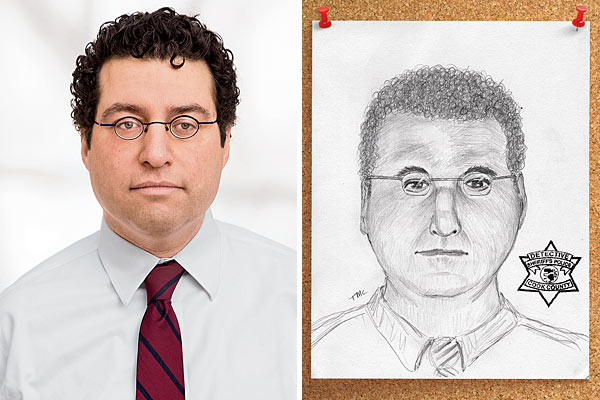
Do you know this man? Timothy McPhillips’s sketch is startlingly similar to the real Dan Libenson.
This isn’t going to work.
Every witness says it, struggling to describe the images in his or her head while a police artist’s pencil scratch-scratch-scratches away on a sketchpad. Many get so frustrated that they break down. But most soldier on, even if the whole thing is like doing a jigsaw puzzle with their eyes closed.
I recently heard that most police departments have eliminated sketch artists in favor of using computers to generate facial composites, which saddened me for a couple of reasons. First, the notion of transmitting your thoughts to the world through someone else’s pencil is really cool—the closest thing to telepathy out there. And those computer programs? If the ten o’clock news is any indication, the software tends to produce creepy faces that look more like botched plastic surgeries than like criminals. Those computer renderings can’t possibly be catching bad guys. But do sketch artists catch bad guys? I decided to seek one out to see how—and if—the process really worked.
Only two FBI-trained forensic sketch artists remain in the Chicago area. One is Timothy McPhillips. A third-generation police officer and a homicide detective with the Cook County sheriff’s police, McPhillips looks like a character from The Wire: beefy, tough, Irish. But he’s also a sensitive guy who has been doodling for most of his life and has gotten pretty good. For every ten times he sits down to coax data from a witness’s brain, three lead to a suspect’s arrest or identification—a fact that still amazes him. “I’m reading a video image inside a witness’s head, and I’ve never seen that person before,” says McPhillips, 52. “Next thing I know, they’re saying, ‘Yeah, that looks like the guy.’”
To prove it, McPhillips had me think of a friend at random. I picked Dan Libenson, then leafed through an FBI catalog of mug shots organized by features, choosing elements I thought fit Dan: big forehead, round cheeks, curly hair, small glasses. After some general questions, McPhillips began to draw the eyes. Always the eyes first. “I work from the center of the face outward,” he said. “Keeps my work proportional.”
He put me at ease by asking about my family, never interrupting and never losing his patience, even as I started rearranging Dan’s face. Did I say thin eyebrows? No, thick. Thicker. Yeah, like they ate Martin Scorsese’s eyebrows. The nose looked weird, and something about the chin was off. As McPhillips took his electric eraser to both, I panicked. Here I was trying to describe a guy I knew—not a stranger who had mugged me and then vanished—and I couldn’t do it.
“A lot of people in law enforcement still don’t believe a witness’s mental image can be transferred to someone else’s drawing,” says Brian White, McPhillips’s commander. “Until it works for them.” Many police districts in Chicago consider sketch artistry to be some kind of peculiar hocus-pocus, opting instead for the computer composites. But, White says, those almost never break a case. A computer can’t empathize with the witness or tease out unique details during an interview, nor can it adjust or improvise. “A sketch compared with a computer composite is like driving a Cadillac instead of a Ford Escort,” White says.
If police sketches work and computer composites don’t, then why does a metropolitan area with ten million people employ only two part-time sketch artists? (McPhillips’s colleague Luis Santoyo, who doubles as a patrolman, is the other one.) Skepticism is only part of the answer. Money is another part: It’s cheaper for an office to install software than to hire a full-time artist. (Training an officer to use the software is another story.) But the main reason sketch artists are going the way of elevator operators is that cops like McPhillips and Santoyo don’t come along often. They’re trained police officers with a priest’s patience and an artist’s insight—and they still believe that the human eye is the world’s best camera. “Some images are blurry, but even if you look at a person for a split second, that image is in there,” Santoyo says. “It’s just a matter of getting it out.”
After two hours, I glanced at McPhillips’s sketch, and to my surprise, looking back at me was Dan, more or less. It wasn’t exactly a Cadillac. A Jetta, maybe. I realized later I had described his hair and his glasses wrong, but if the real Dan had been wandering around the area, he would have been apprehended, and that’s the whole idea. Since July 2010, 15 of McPhillips’s drawings have resulted in identification or arrest; his work broke the case in the Indian Head Park murder last October. “That’s why I do this, to help get a bad guy off the street,” he said, putting away his pencils. “But also, I like to draw.”
Photograph: Kendall Karmanian; Illustration: Timothy McPhillips



Comments are closed.